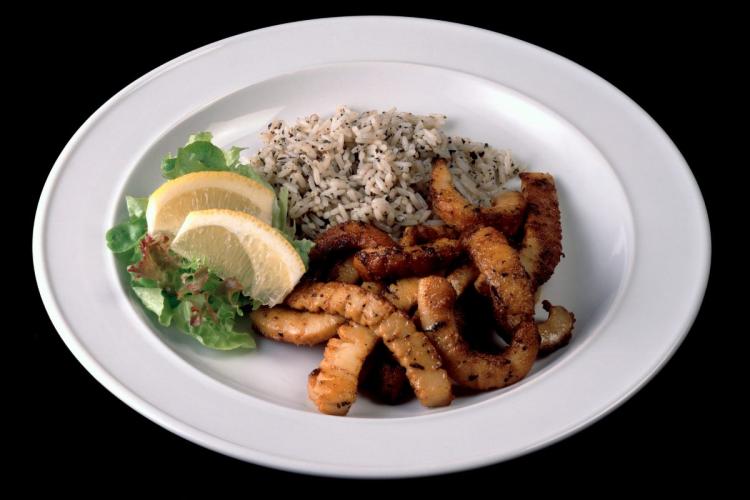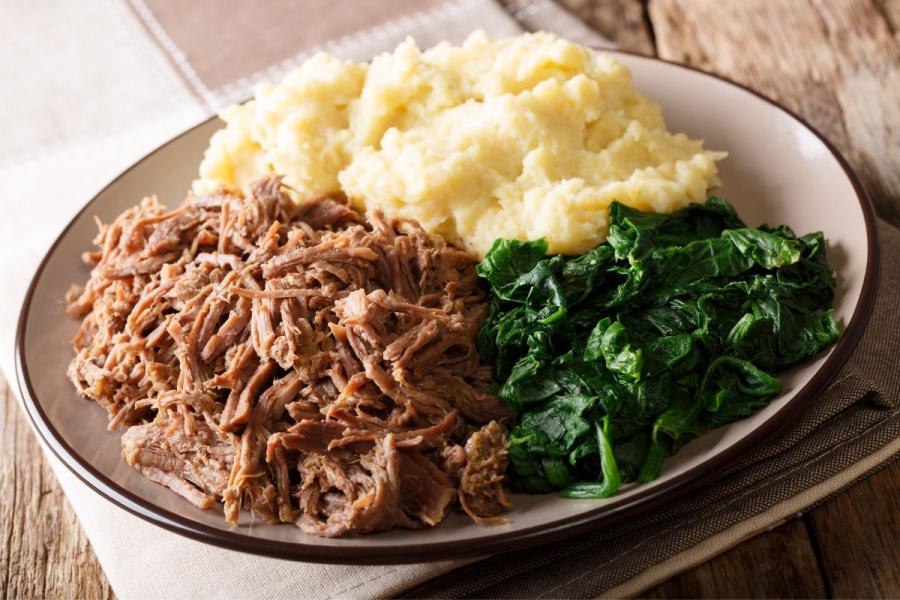Food in Zimbabwe
Savoring the unique flavors.
Curious about the essentials of food in Zimbabwe? This guide takes you beyond the surface with a deep dive into the hearty sadza, the protein-rich mopane worms, and the cuisine’s colonial influences. Learn not just what dishes to savor but also the stories they tell of Zimbabwe’s heritage and social customs.
This is Zimbabwe food
- Sadza, a versatile maize-based stiff porridge, is Zimbabwe’s national dish and is usually served with meats or greens like muboora, while mopane worms offer a unique, protein-rich culinary experience.
- Zimbabwean cuisine reflects a blend of cultural influences, with British customs contributing to breakfast and tea traditions and Portuguese culinary practices introducing peanuts, influencing dishes like Dovi (peanut butter stew).
- Food and beverages play a central role in Zimbabwean culture and celebrations, with traditional meats and vegetables on offer, but the country faces significant challenges with food security, affecting millions of people, including children.
Zimbabwean Staples and Dishes
In Zimbabwe, food is not just fuel - it’s a central part of daily life, a unifier at celebrations, and a tapestry of the country’s rich history. At the heart of Zimbabwean food is maize, the staple food for many Zimbabweans. This versatile grain is commonly used to make mealie meal, a thick porridge often enriched with additions like vegetables, meat, onions, tomatoes, and groundnuts.
The national dish, sadza, is a stiff porridge made from white maize and is a central part of traditional meals. While it’s usually served with nyama (meat stew), other accompaniments include stews made with pumpkin leaves, known as muboora, and the highly valued mopane worms, locally referred to as madora or macimbi. These caterpillars, especially popular in the regions of Matabeleland and the Midlands, are a testament to Zimbabwe’s rich and diverse cuisine.
Sadza is the national dish
Think of sadza as Zimbabwe’s answer to mashed potatoes or rice - a versatile, comforting base for a multitude of dishes. It’s a stiff porridge made from maize or corn flour, usually served rolled into a ball for dipping into a variety of dishes.
The traditional companions to sadza are meats like beef or chicken stew. For the vegetable sides, you might find pumpkin leaf relish cooked with or without peanut butter or a vegetable called covo, similar to chard. This delightful mix of flavors makes sadza a must-try for anyone seeking a true taste of Zimbabwean cuisine.
Mopane worms are a delicacy
If you’re an adventurous eater, mopane worms are a must-try. Known locally as madora or macimbi, these caterpillars are the larvae of the Emperor moth, Imbrasia belina, and are a popular delicacy in Southern Africa. They are sought after for their high protein content, making them not just tasty but also highly nutritious.
In traditional Zimbabwean cuisine, mopane worms are consumed stewed or fried, often accompanied by other ingredients like garlic, onions, tomatoes, and spices. This might seem unusual to some, but it’s a true testament to the unique and diverse nature of Zimbabwean cuisine.
Nyama is a hearty beef stew
Nyama, a traditional Zimbabwean beef stew, is another staple you’ll find on many a dining table. The primary ingredient in nyama is, as you might have guessed, beef. This hearty stew is often prepared with added vegetable leaves or beans for extra flavor and nutrition. When you eat beef in Zimbabwe, nyama is a must-try dish.
Typically, nyama is enjoyed with sadza, though it can also be served with rice, making it a versatile dish that’s full of flavor and a true taste of Zimbabwe.
Cultural influences on Zimbabwean cuisine
Zimbabwe’s cuisine is the product not just of its native traditions, but also of the cultural influences it has absorbed over the centuries. Two of the most significant of these are the British and Portuguese culinary traditions, which have left their mark on the country’s food in a variety of ways.
Common British culinary elements like bread and tea, as well as the use of spices and sugar, have been integrated into the daily life of Zimbabweans. Compared to neighboring countries with Portuguese influence, Zimbabwe’s cuisine is characterized by a less pronounced use of chili peppers and spices, echoing the British colonial culinary preferences.
These adaptations of British and Portuguese food customs and ingredients are emblematic of the lasting impact of colonial rule on the eating habits and dietary preferences in Zimbabwe.
British customs
One aspect of British influence is clearly seen in the Zimbabwean breakfast table. Porridge, introduced by the English, has become a staple breakfast item in Zimbabwe, with a distinct local twist. Bota, a porridge made with:
- cornmeal
- peanut butter
- milk
- sometimes jam
reflects the British influence on Zimbabwean breakfast habits.
The British colonization has also left a lasting imprint with the daily practices of having tea at midday and 4 o’clock before dinner. These customs, though now thoroughly Zimbabwean, have their roots in British tradition and are a testament to the enduring influence of colonial rule.
Portuguese contributions
Portuguese contributions have also shaped Zimbabwean cuisine in significant ways. The Portuguese introduced peanuts to Zimbabwe in the 16th century, leaving a lasting mark on the country’s culinary practices.
Peanuts have become an integral part of Zimbabwean cuisine, frequently seen in various main dishes. One such dish is the peanut butter stew, also known as Dovi, a traditional Zimbabwean stew made with peanut butter, meat, or vegetables. This classic example showcases the fusion between local traditions and Portuguese-introduced ingredients.
Celebrations and special occasions
Celebrations are a time for families and communities to come together, and in Zimbabwe, these occasions are marked by an abundance of traditional dishes. Some popular dishes include:
- Sadza, a staple food made from cornmeal, served with stews made from a variety of meats
- Chomolia, a leafy green vegetable, served with peanut butter
- Tender boiled butternut squash
Food plays a central role in these gatherings of ethnic groups, as everyone comes together to eat food and enjoy these traditional dishes, often best when eaten fresh, including the holiday celebrations meat. These traditional foods are an essential part of the experience.
Special occasions in Zimbabwe also boast a variety of meats including game like:
- ox
- goat
- ostrich
- kudu
- warthog
In addition, fresh produce like leafy greens, young corn, fresh fruit, and fresh vegetables are also commonly enjoyed. During Christmas and summer harvest celebrations, sadza is a staple dish, while desserts typically involve fruits or Western-style chocolate variations with Amarula liqueur sauce.
Dining etiquette and mealtime traditions
Every culture has its own dining etiquette and mealtime traditions, and Zimbabwe is no different. In Zimbabwe, it’s customary to wash hands before eating, a task typically carried out by women, especially for men and guests.
Meals in Zimbabwe are usually enjoyed in the following way:
- On low stools or around a mat on the floor
- Communal dining is common during festivities
- Guests of honor and elders are served first, followed by others
- Women typically eat last
- It’s also common to ask for permission before leaving the table after a meal, a sign of respect for the hosts and the meal shared.
Zimbabwean beverages
Just as food is integral to Zimbabwean culture, so are beverages. Zambezi beer holds the title of being Zimbabwe’s national alcoholic beverage and is the most popular alcoholic drink in the country.
Non-alcoholic options are also plentiful. Maheu, a non-alcoholic drink that can be transformed into an alcoholic beverage if left to ferment, is popular. Recently, there has been an expanding market for healthier non-alcoholic beverage options among Zimbabweans, reflecting a growing interest in healthier living, including sour milk as a nutritious choice.
Nutritional challenges and food security
While Zimbabwe’s cuisine offers a rich tapestry of flavors and traditions, the country faces significant challenges in terms of food security and nutrition. Erratic weather patterns leading to recurring floods and droughts have resulted in a severe food insecurity crisis impacting 4.1 million people.
The situation was further compounded by:
- Cyclone Idai in 2019, which disrupted efforts to recover and stabilize food availability
- Approximately 39 percent of Zimbabwe’s population is classified as poor
- Approximately 16 percent of children under the age of five are underweight
These statistics highlight the critical challenges in child nutrition and health.
Must-Try Zimbabwean foods for travelers
For travelers looking to immerse themselves fully in Zimbabwean culture, trying the local cuisine is a must. Peanut butter is a key ingredient in many Zimbabwean main dishes due to Portuguese culinary influence.
Mupunga unedovi, a traditional dish that combines rice and peanut butter, is a perfect example of the fusion of Portuguese influences in local cuisine. Another must-try is muriwo unedovi, which consists of green vegetables in a peanut butter sauce, commonly paired with staples such as peanut butter rice or sadza.
Zimbabwe food
Zimbabwean cuisine is a fascinating blend of traditional African ingredients, British customs, and Portuguese influences. From the staple maize dishes and the unusual mopane worms to the hearty nyama and the peanut-infused dishes showing Portuguese influence, it’s a culinary landscape that tells a story of a rich and varied history. So next time you find yourself in Zimbabwe, be sure to savor these flavors, and remember, every bite is a journey through the country’s diverse gastronomic heritage.
What is the popular food in Zimbabwe?
The popular food in Zimbabwe is sadza, which is a stiff maize meal that is often rolled into a ball and accompanied by meat, sauce, sour milk, or stewed vegetables.
What food did Great Zimbabwe eat?
The people of Great Zimbabwe ate a diet consisting of millet, sorghum, beef, and other cultivated grains, along with products from cattle such as meat, milk, and cheese. They also produced soapstone figurines. So, their diet mainly included grains and products from cattle.
What is Zimbabwe national dish?
The national dish of Zimbabwe is Sadza, a staple that has been the cornerstone of Zimbabwean tables for generations, nourishing both body and soul with its simple yet profound preparation.
What is the staple food in Zimbabwe?
The staple food in Zimbabwe is maize, which is commonly used to make a thick porridge called sadza. Enjoy your meal!
What cultural influences are seen in Zimbabwean cuisine?
Zimbabwean cuisine shows cultural influences from British and Portuguese traditions, with elements like bread, tea, and peanuts. These influences have shaped the unique flavors and dishes of Zimbabwean cuisine.


